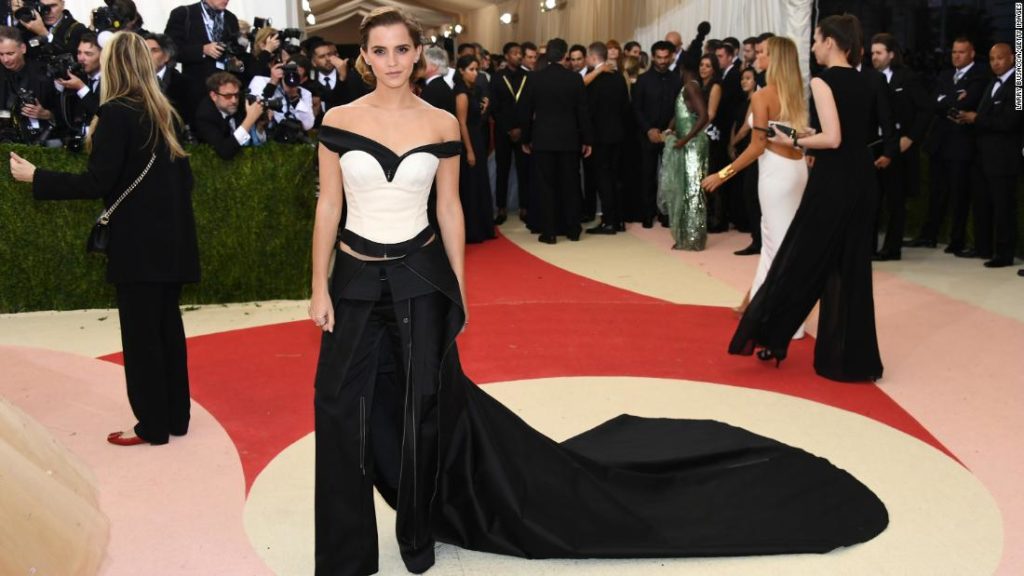Only just over a decade ago, sustainability in fashion was a fringe issue. But today, it has become a major talking point — even at important red carpet events, as evidenced by this year’s Oscars.

Saoirse Ronan attended the 92nd Oscars in a gown made, partly, with leftover fabric from her Baftas dress earlier that month. Credit: Amy Sussman/Getty Images

Livia Firth’s custom tangerine caftan by Richard Quinn for the 2019 Met Gala featured recycled plastic bottles and Swarovski upcycled crystals. Credit: Dia Dipasupil/FilmMagic/Getty Images
Emma Watson dons dress made of used plastic bottles

Viola Davis wore a Valentino gown for the Green Carpet Challenge to the 2012 Baftas. Its fabric was crafted from recycled materials. Credit: Richard Young/Shutterstock
Getting stars to make greener choices wasn’t a straightforward process, according to Samata Pattinson, the CEO of Red Carpet Green Dress. Initially, “it was really difficult to get talent on board with our campaign, because they had a limited view of what it would look like,” she said in an email interview.
“They were anxious, they didn’t know if it would look good. The assumption was that it would be hemp, something ‘granola.'”
But as awareness of fashion’s devastating impact on the climate grows, so too does interest from celebrities.
“The red carpet is one of the biggest storytelling platforms there is, and an opportunity to change conversations,” said Harriet Vocking, the chief brand officer of Eco-Age, discussing the Green Carpet Challenge in a phone interview. “Wearing a sustainable garment (at award ceremonies) has become a way to lead by example, but also challenge the current fashion system.”

Costume designer Arianne Phillips upcycled the Moschino dress she first wore at the 2012 Oscars (above) into a new gown for the 2020 ceremony (below). Credit: Ethan Miller/Getty Images

The new version was created in collaboration with Moschino’s Jeremy Scott. Credit: Amy Sussman/Getty Images
To date, Eco-Age has worked with more than 250 celebrities to shine a light on sustainability, although Vocking, like Pattinson, also spoke of having to persuade people at first, “as opposed to now, where we have incoming requests.”
Vocking pinpointed Watson’s Calvin Klein dress as a pivotal moment for the sustainable red carpet movement. “Watson propelled the dialogue to new heights, because her gown was so well-received by everyone, and showed that the quality is there to make stunning and sustainable dresses,” she explained. “It moved the needle on how we see sustainable fashion.”

Model Adut Akech attends the Green Carpet Fashion Awards in 2019. Her turquoise Valentino “eco-couture” gown was made of reclaimed materials and organic silk. Credit: Stefania D’Alessandro/Getty Images

Joaquin Phoenix wore the same Stella McCartney tuxedo to successive awards ceremonies. Credit: Frazer Harrison/Getty Images
The bigger picture
Of course, there’s only so much a red carpet dress can do in terms of tangible change. What’s more, award shows themselves have a huge carbon footprint, with large amounts of energy required to stage them, and the waste left to be disposed of in their aftermath. Not to mention the air travel required of stars and their entourages.
The process of dressing celebrities for the red carpet is undeniably wasteful too, with custom-made gowns and jewelry flown over, only to be worn once, feeding into fast-fashion’s obsession with newness.

Thandie Newton wore a Vivienne Westwood dress to the 2018 Cannes Film Festival premiere of “Solo: A Star Wars Story.” The dress, created in collaboration with Eco-Age, featured hand-painted renderings of the Black characters in the franchise, and was made of organic ‘peau de soie’ silk and upcycled crystals. Credit: Pascal Le Segretain/Getty Images

Léa Seydoux’s Louis Vuitton dress, worn to the 2020 Oscars, was created in partnership with the Red Carpet Green Dress initiative. The gown incorporated a textile made from Tencel luxe filament yarn, and organic silk faille paired with organic satin sandals. Credit: Amy Sussman/Getty Images
Neither green carpet initiative has shied away from these inconvenient truths. Rather, they’ve approached sustainability from different angles.
“In the beginning, we were really looking at certified materials and sustainable design solutions with dyes for example, but (our ethos) has grown to include wider conversations (from) refurbishing and repurposing, plant-based or vegan materials, and using recycled plastic, to circular design systems,” Pattinson said. “It’s also grown to more visibly include a social justice element — how we are treating people within this industry and how we treat the people who make our clothes.”

Timothée Chalamet’s Prada outfit at the 2020 Oscars was made using yarn made from regenerated nylon, created from materials such as ocean plastics, fishing nets and textile fiber waste. A vintage Cartier brooch finished the look. Credit: Amy Sussman/Getty Images
“Raising awareness works,” Vocking said. “But for positive impact to be real, every single step of the chain has to be taken into consideration.”
Update: A quote in this story was amended after publication for clarity.
You may also like
-
Afghanistan: Civilian casualties hit record high amid US withdrawal, UN says
-
How Taiwan is trying to defend against a cyber ‘World War III’
-
Pandemic travel news this week: Quarantine escapes and airplane disguises
-
Why would anyone trust Brexit Britain again?
-
Black fungus: A second crisis is killing survivors of India’s worst Covid wave

